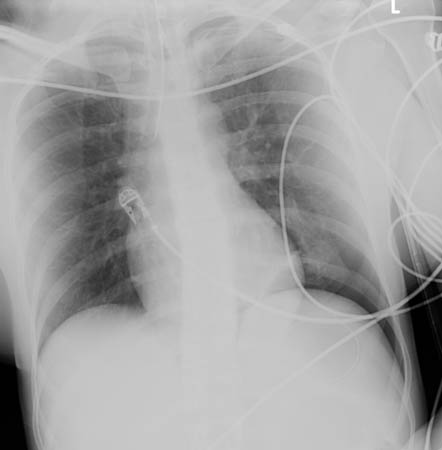大多数骨折都与高能冲击有关,因此特定区域骨折的发病率与该区域胸部钝器伤的总数直接相关。约 10% 到 55% 的胸部钝器伤会导致肋骨骨折,年龄越大,发病率越高。随着年龄的增长,脆性骨折的绝对风险与患者的骨矿物质密度成反比,这类骨折中约 27% 可见于肋骨。[9]Siris ES, Brenneman SK, Barrett-Connor E, et al. The effect of age and bone mineral density on the absolute, excess, and relative risk of fracture in postmenopausal women aged 50-99: results from the National Osteoporosis Risk Assessment (NORA). Osteoporos Int. 2006;17:565-574.http://www.ncbi.nlm.nih.gov/pubmed/16392027?tool=bestpractice.com此外,与摔倒相关的老年人肋骨骨折病例数预计会随着人口整体年龄的增长而增加。[10]Palvanen M, Kannus P, Niemi S, et al. Epidemiology of minimal trauma rib fractures in the elderly. Calcif Tissue Int. 1998;62:274-277.http://www.ncbi.nlm.nih.gov/pubmed/9501963?tool=bestpractice.com45 岁以上的患者发生多发性肋骨骨折的风险也会增加,且与年轻人相比,发病率和死亡率都显著升高。[11]Holcomb JB, McMullin NR, Kozar RA, et al. Morbidity from rib fractures increases after age 45. J Am Coll Surg. 2003;196:549-555.http://www.ncbi.nlm.nih.gov/pubmed/12691929?tool=bestpractice.com[12]Kent R, Woods W, Bostrom O. Fatality risk and the presence of rib fractures. Annu Proc Assoc Adv Automot Med. 2008;52:73-82.http://www.ncbi.nlm.nih.gov/pubmed/19026224?tool=bestpractice.com
在肋骨骨折病例中,约 14% 至 35% 会发生气胸、 [Figure caption and citation for the preceding image starts]: CT 扫描显示大范围左侧气胸由 Paul Novakovich 博士收集提供;经许可后使用 [Citation ends].
[Figure caption and citation for the preceding image starts]: CT 扫描显示大范围左侧气胸由 Paul Novakovich 博士收集提供;经许可后使用 [Citation ends]. [Figure caption and citation for the preceding image starts]: CXR 所描绘的气胸与 CT 所示一致由 Paul Novakovich 博士收集提供;经许可后使用 [Citation ends].约 20% 至 25% 会发生血气胸、约 17% 会发生肺挫伤、约 5.8% 会发生连枷胸;发病率随着骨折数的增加而升高。[1]Sirmali M, Türüt H, Topçu S, et al. A comprehensive analysis of traumatic rib fractures: morbidity, mortality and management. Eur J Cardiothorac Surg. 2003;24:133-138.http://ejcts.oxfordjournals.org/content/24/1/133.longhttp://www.ncbi.nlm.nih.gov/pubmed/12853057?tool=bestpractice.com[13]Keel M, Meier C. Chest injuries - what is new? Curr Opin Crit Care. 2007;13:674-679.http://www.ncbi.nlm.nih.gov/pubmed/17975389?tool=bestpractice.com[14]Liman ST, Kuzucu A, Tastepe AI, et al. Chest injury due to blunt trauma. Eur J Cardiothorac Surg. 2003;23:374-378.http://ejcts.oxfordjournals.org/content/23/3/374.longhttp://www.ncbi.nlm.nih.gov/pubmed/12614809?tool=bestpractice.com
[Figure caption and citation for the preceding image starts]: CXR 所描绘的气胸与 CT 所示一致由 Paul Novakovich 博士收集提供;经许可后使用 [Citation ends].约 20% 至 25% 会发生血气胸、约 17% 会发生肺挫伤、约 5.8% 会发生连枷胸;发病率随着骨折数的增加而升高。[1]Sirmali M, Türüt H, Topçu S, et al. A comprehensive analysis of traumatic rib fractures: morbidity, mortality and management. Eur J Cardiothorac Surg. 2003;24:133-138.http://ejcts.oxfordjournals.org/content/24/1/133.longhttp://www.ncbi.nlm.nih.gov/pubmed/12853057?tool=bestpractice.com[13]Keel M, Meier C. Chest injuries - what is new? Curr Opin Crit Care. 2007;13:674-679.http://www.ncbi.nlm.nih.gov/pubmed/17975389?tool=bestpractice.com[14]Liman ST, Kuzucu A, Tastepe AI, et al. Chest injury due to blunt trauma. Eur J Cardiothorac Surg. 2003;23:374-378.http://ejcts.oxfordjournals.org/content/23/3/374.longhttp://www.ncbi.nlm.nih.gov/pubmed/12614809?tool=bestpractice.com
 [Figure caption and citation for the preceding image starts]: CT 扫描显示大范围左侧气胸由 Paul Novakovich 博士收集提供;经许可后使用 [Citation ends].
[Figure caption and citation for the preceding image starts]: CT 扫描显示大范围左侧气胸由 Paul Novakovich 博士收集提供;经许可后使用 [Citation ends]. [Figure caption and citation for the preceding image starts]: CXR 所描绘的气胸与 CT 所示一致由 Paul Novakovich 博士收集提供;经许可后使用 [Citation ends].约 20% 至 25% 会发生血气胸、约 17% 会发生肺挫伤、约 5.8% 会发生连枷胸;发病率随着骨折数的增加而升高。[1][13][14]
[Figure caption and citation for the preceding image starts]: CXR 所描绘的气胸与 CT 所示一致由 Paul Novakovich 博士收集提供;经许可后使用 [Citation ends].约 20% 至 25% 会发生血气胸、约 17% 会发生肺挫伤、约 5.8% 会发生连枷胸;发病率随着骨折数的增加而升高。[1][13][14]